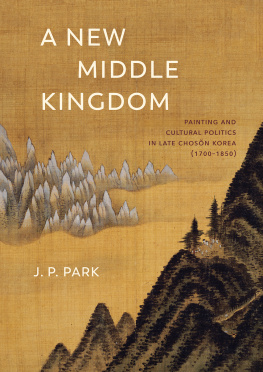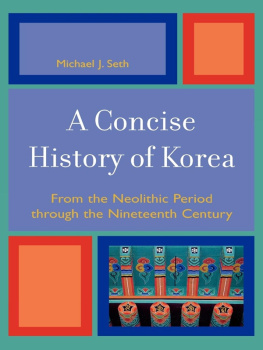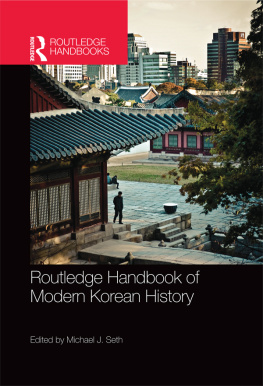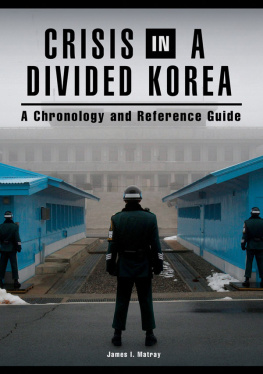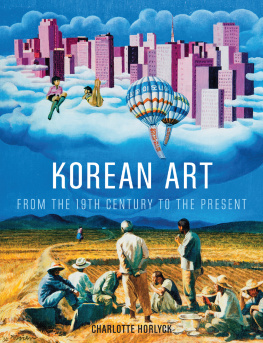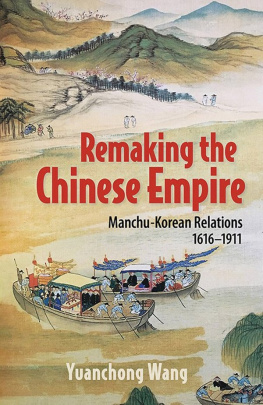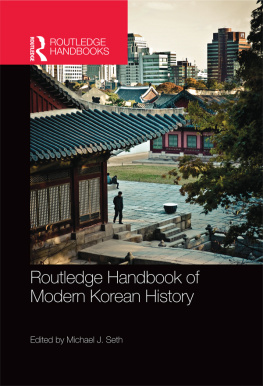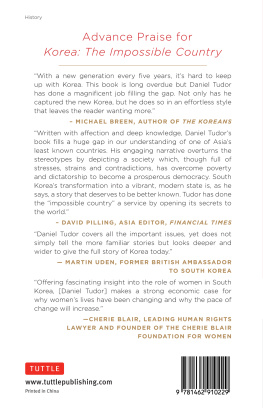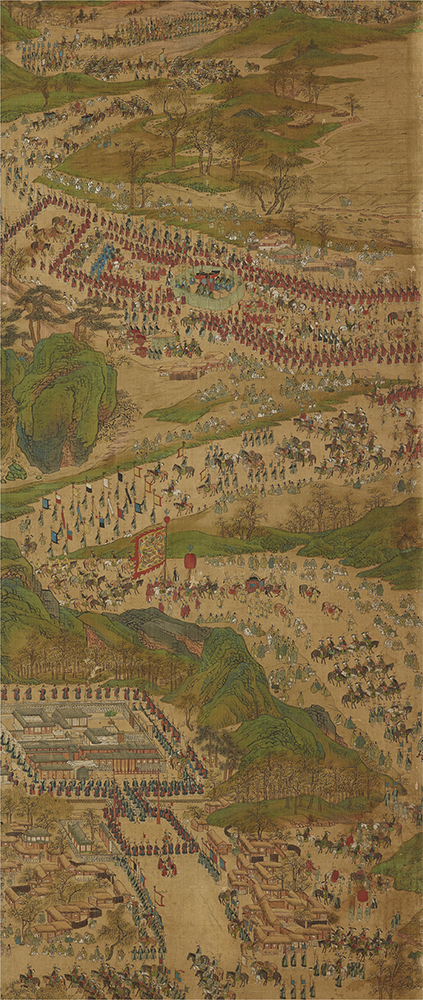A NEW
MIDDLE
KINGDOM
A NEW
MIDDLE
KINGDOM
PAINTING AND
CULTURAL POLITICS
IN LATE CHOSN KOREA
(17001850)
J. P. PARK
A William Sangki and Nanhee Min Hahn Book
UNIVERSITY OF WASHINGTON PRESS | Seattle
A New Middle Kingdom was supported by a generous grant from the William Sangki and Nanhee Min Hahn Fund for Books on East Asia.
The Korea Foundation has provided additional financial assistance for the undertaking of this publication project.
Publication has also been aided by a grant from the Millard Meiss Publication Fund of the College Art Association.
The Metropolitan Center for Far Eastern Art Studies supported this book.
Additional funding was provided by the Hellman Foundation and the University of California, Riverside.
Copyright 2018 by the University of Washington
Press Printed and bound in China
Interior design by Katrina Noble
Composed in Minion, typeface designed by Robert Slimbach
22 21 20 19 18 5 4 3 2 1
All rights reserved. No part of this publication may be reproduced or transmitted in any form or by any means, electronic or mechanical, including photocopy, recording, or any information storage or retrieval system, without permission in writing from the publisher.
UNIVERSITY OF WASHINGTON PRESS
www.washington.edu/uwpress
LIBRARY OF CONGRESS CATALOGING-IN-PUBLICATION DATA
Names: Park, J. P., author.
Title: A new Middle Kingdom : painting and cultural politics in late Chosn Korea (1700-1850) / J.P. Park.
Description: Seattle : University of Washington Press, 2018. | Includes bibliographical references and index. |
Identifiers: LCCN 2018002457 (print) | LCCN 2018004781 (ebook) | ISBN 9780295743264 (ebook) | ISBN 9780295743257 (hardcover : alk. paper)
Subjects: LCSH: Painting, KoreanChosn dynasty, 13921910. | Arts and societyKoreaHistory. | KoreaCivilization13921910.
Classification: LCC ND1063.4 (ebook) | LCC ND1063.4 .P37 2018 (print) | DDC 759.9519/02dc23 LC record available at https://lccn.loc.gov/2018002457
Jacket illustration: Chng Sn (16761759), Gazing at Mount Kmgang from Tanbal Pass (Tanballyng mang Kmgang), 1711. Album leaf, ink and light colors on silk, 37.6 36.1 cm. National Museum of Korea
Frontispiece: Kim Tksin (17541822) et al., Royal Processions to the Ancestral Tomb in Hwasng, ca. 1795. A panel in an eightfold screen, ink and colors on silk, 147 62.3 cm. Leeum, Samsung Museum of Art
For Sooyoung Lee and Chulkyu Park, the two people who love me most
CONTENTS
ACKNOWLEDGMENTS
As much as anything else in my life, this manuscript could not have been completed without the advice and support of many people and institutions. Research for the project was facilitated by the opportunities and funding generously provided by the Korea Foundation, the Hellman Foundation, Princeton University, the University of California-Riverside, the American Philosophical Society, and the Metropolitan Center for Far Eastern Art Studies in Kyoto. My longtime friends Lee Sukyung and Min Kilhong at the National Museum of Korea and Jo Jiyoon at Leeum in Seoul helped me tremendously by introducing me to rare paintings housed at their institutions. I am also deeply grateful to Pierre Cambon at Muse Guimet for his kindness and consideration during my research in Paris.
My colleagues at the University of California Conrad Rudolph, Aleca Le Blanc, Jason Weems, Johannes Endres, Kris Neville, and Jeannette Kohl have been consistently supportive. Special thanks must go to Malcolm Baker for sharing his insights when I hit a dead end in my research: his suggestion singlehandedly put me back on track. I also truly appreciate the late Professor James Cahill for all of his brilliant research, raising a high bar for historians of Asian art. Martin Powers has been a towering beacon whenever my own research seemed about to derail. My friends in the field, Kirk Ambrose, Craig Peariso, Sarah Cartwright, Heidi Gearhart, David Parker, Zoe Kwok, Jen Zhu, Yunjung Seo, Kristina Kleutghen, Nayeon Kim, Vadim Jigoulov, Michelle Wang, Virginia Moon, Heather Vinson, Najung Kim, Chris De Fay, Sun-ah Choi, Joyce Tsai, Maya Stiller, Stephen Whiteman, Dora Ching, Javier Cha, Mina Kim, Kyunghee Choi, Minku Kim, Liu Bo, Rebecca Bieberly, Charlotte Horlyck, Jaebin Yu, Jungmin Ha, and Wu Yang have provided me both academic and moral support through the completion of this project. My teachers and senior colleagues, Jerome Silbergeld, Burglind Jungmann, Freda Murck, Cary Liu, Katharine Burnette, Richard Vinograd, Tamara Bentley, Robert Harrist, Wu Hung, Jenny Purtle, Stanley Abe, Roslyn Hammers, Peter Sturman, Hui-shu Lee, Yukio Lippit, Shen Kuiyi, Cheng-hua Wang, Patricia Berger, Eugene Wang, Heping Liu, Lee Sng-mi, Hong Snpyo, Yi Taeho, David Rolston, Lothar von Falkenhausen, Celeste Brusati, Juhyung Rhi, Ahn Hwi-joon, Haewon Kim, Hawon Ku, Cho Kyuhee, Insoo Cho, Chin-sung Chang, Lee Soo-mi, Tim Brook, and Craig Clunas also deserve my thanks here.
Although Ive never had the honor of meeting them in person, Ann Bermingham, Eddy de Jongh, Denis Cosgrove, and John Barrell provided the theoretical and interpretive methodologies I dont think I could have developed and refined myself. Sonja Sekely-Rowland, the director of the Visual Resources Center at UCR, has helped me tremendously in clearing copyright permissions of a number of images. Furthermore, Lorri Hagman at the University of Washington Press must be warmly credited for bravely taking on and producing this ambitious and potentially controversial project. My trustworthy and punctual editor and friend, Terre Fisher, helped polish my writing for logic and merit.
Finally, I want to express my deepest love and appreciation to my parents, Chulkyu Park and Sooyoung Lee, who have always given me generous support, allowing their son who suffers from serious wanderlust to be constantly on the move to satisfy his curiosity while pursuing research. I hope this book can repay at least a little bit of the love I have received from them.
AUTHORS NOTE
Romanization of Korean terms follows the McCuneReischauer system. Romanized terms are Korean (K.) unless identified as Chinese (Ch.), using the Pinyin system, or Japanese (J.), using the modified Hepburn system.
Dates are given according to the East Asian lunar calendar. Approximate biographical dates are sometimes indicated by a milestone event, such as the year in which an individual passed a civil service examination (e.g., jinshi 1460).
A NEW
MIDDLE
KINGDOM
CONFLICTED REALITIES
MODERNITY AT LARGE IN LATE CHOSN SOCIETY
A vision of the world is a division of the world.
PIERRE BOURDIEU, The Logic of Practice
THE LATE CHOSN PERIOD, FROM APPROXIMATELY THE LATE SEVENTEENTH TO the early nineteenth century, was a time of great change, not only throughout the Korean Peninsula but also across East Asia. In politics, mainland China had a major regime change, and Japan hailed a new ruling family; both powers governed their states in relative peace and prosperity until the mid-nineteenth century. Meanwhile, as European countries competitively turned their attention to the east, these three states began to take a growing interest in Western science and technology. On a sociocultural level, East Asia was developing an unmistakable degree of modernity: an educated middle class enjoyed urban life, commerce and trade was having a heyday, and artistic leisure had come to be democratized across different classes. The Chosn dynasty (13921910) was no exception, yet many of these developments evolved rather differently than in neighboring China and Japan. Late Chosn Korea faced so many challenges that its subsequent societal and moral transformations tended to sharply contradict preexisting ideology and customs.

